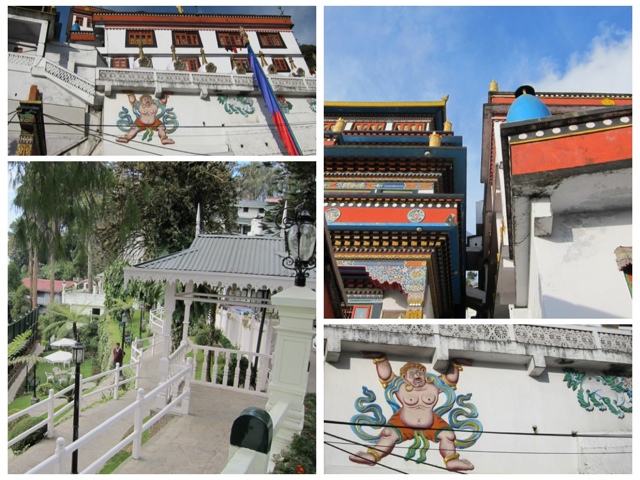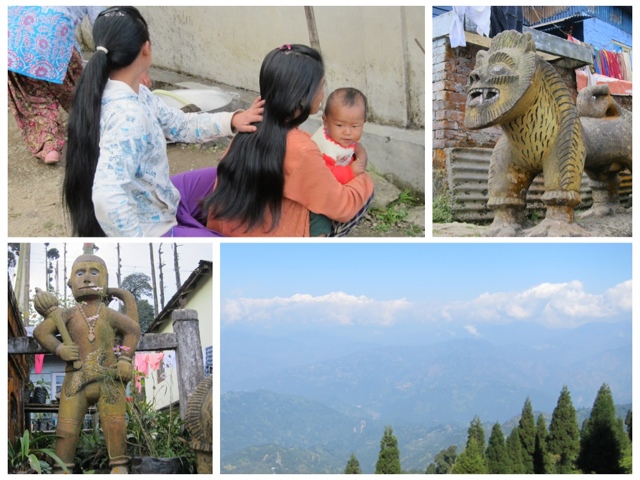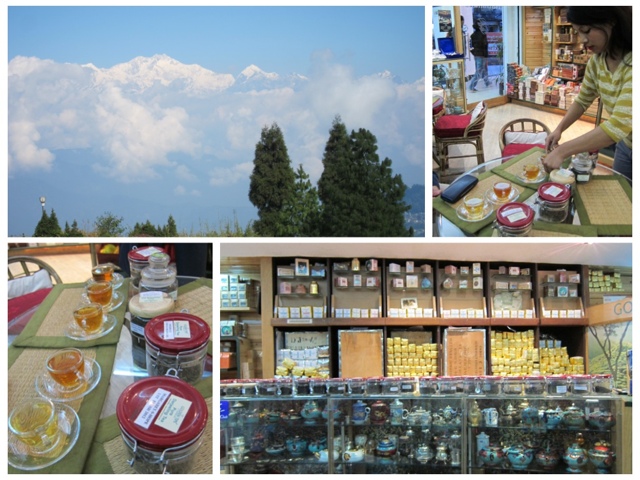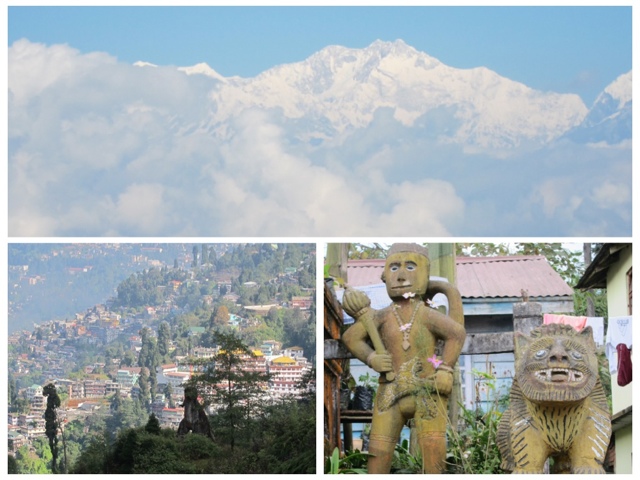Darjeeling, the land of the Thunderbolt... Seeing a sand mandala and learning about mountain climbers
Sometime you just happen to be at the right place at the right time... And you feel infinitely grateful for the Divine guidance that led you there.
When we drove into Darjeeling, we saw a large Buddhist temple at the entrance to town.
It was a new temple, and not one that was on our itinerary to visit.
But the monastery looked very intriguing..... and so while all of the other tourists in our hotel made plans to wake up at four in the morning to go to Tiger Hill, from which you can view Mount Everest and Mount Kanchenjunga at sunrise, we looked into the stars and decided that we will sleep late, have a leisurely breakfast and visit this monastery instead.
David and Sue, a couple of tourists from England that we befriended a few days before, later told us that it was a cloudy morning and that they were not able to see the mountain peaks.
We drove to the monastery, and made our way up the steps.
A toothless old lady urged us to go up, since a celebration was going on...
For five days the monks had been painting a sand Mandala, and we happened to be there on the exact day when the patron of the Monastery was visiting.
The main hall was full of monks, chanting and playing the ancient instruments.
At the left corner of the hall, on a large piece of plywood, the monks were "painting" the mandala with colorful sand.
It was now almost complete, and they were just putting the finishing touches on the edges of the Mandala.
The master artist drew patterns with a pencil in the sand, and the other monks spread on the tracing, tiny pinches of colorful sand, one pinch at a time.
They worked very mindfully and with surgical masks on their faces... Even a small sneeze can blow away hours of work.
This sand painting Mandala ritual is done to celebrate the impermanent nature of the physical world.
The physical world, with its joys and suffering, is nothing but an illusion which only lasts a very short while....
When the Mandala is finished, later that same day, the whole congregation will run over the sand mandala, and hours of beautiful work will resemble a sandbox....
I felt very grateful to be there and to see the sand mandala almost completed.
I have seen it done in documentaries and read about it often, but this was the first time that I got to see it with my own eyes.
The art on the walls of the main hall, was beautiful.
The senior monks were engaged in prayers and I sat and listened to their guttural chants, to the beat of the drums, the joyful brass bells and to the deep sound of the old elongated trumpets....
Young monks blew the conch trumpets, which I was never able to get any sound out of, no matter how many times I tried...
This monastery had a prayer wheel room.
In it, I saw some elderly people and one mentally disabled young man, all of whom had permanent seats in front of the prayer wheel.
Their seat resembled a wooden meditation box, lined with a warm blanket and a pillow.
They pulled a rope that was attached to the prayer wheel, which made it turn without the need to walk around the wheel.
Those who spend their time religiously turning the prayer wheels, believe that every time you say the "OM Mani Padme Hum" mantra, prostrate yourself or turn a prayer wheel, you gain merit.
The more you do it, the more you advance towards enlightenment, and the more you release yourself from the effects of negative Karma.
It reminded me that while in Bhutan, I asked our guide Sonam how his mother was doing, since I knew that she was recovering from an operation.
Sonam said that his mother was doing well.
He said that the doctors told her to exercise, and so she now she was doing five hundred full body prostrations per day, in front of the family altar....
She believed that it is a most effective exercise, PLUS, she gained a LOT of merit for her devotion as well...
We walked through the Darjeeling Zoo, to look at the HMI, the Himalayan Mountaineering Institute.
We saw an exhibition of all the past mountaineers who have climbed the tall peaks in the area, especially Mount Everest.
It was very interesting to see all the climbing equipment that was used sixty years ago, and to compare it to the high tech gear and equipment used today.
It was fascinating to learn more details about extreme mountain climbing expeditions.
Darjeeling is the home of Tenzing Norgay Sherpa, the Sherpa who climbed Mount Everest with Edmund Hillary in 1953.
After years of dreaming and seven weeks of climbing, New Zealander Edmund Hillary and Nepalese Tenzing Norgay reached the top of Mount Everest, the highest mountain in the world, on May 29, 1953.
They were the first people to ever reach the summit of Mount Everest.
We saw the grave of Tenzing Norgay, and a bronze statue of the Sherpa stood proud bedside it.
We also saw the house of Tenzing Norgay, which stands on the slopes of Darjeeling.
It is a very large house, and we were told that his son and relatives still live there.
I was not familiar with the fact that the word "Sherpa," does not only refer to the occupation of helping climbers and assisting expeditions, carrying gear and supplies, it is also a Nepali Caste.
The Sherpas are a caste who are known to be people of strong constitution, with much stamina, broad shoulders and strong legs and backs.
On the streets of Darjeeling, we saw many spices and nut sellers.
I bought a large supply of Saffron from Kashmir.
We changed some money in a "Money Exchange," that doubled as a sari shop and tailoring cum souvenir shop.
At a tea store, we tasted twelve kinds of teas and bought some good tea to take home.
It was almost nighttime, and we walked into the Chawrasta Market Bazar, which is the only place in Darjeeling where cars were not allowed.
A dance was being performed on the main stage, and we browsed for a long time in the Oxford Bookstore, which was filled with interesting titles that you would only be able to find in the Himalayas.
If I could have, I would have bought many more books than the twelve that we bought to take home.
In one of the Buddhist jewelry shops, I bought two real Dzi beads that were not so old, and therefore not too pricy.
We saw a good bakery with good coffee, a few interesting curio shops and so much street food which we have never seen before.
Darjeeling derived its name from the Tibetan language.
Dorjee-Ling, means the "Place Of The Thunderbolt."
Guru Rinpuche (Padmasambava,) which is worshiped in this region just as much as in Bhutan, is always depicted holding a thunderbolt in his right hand.
The thunderbolt is a symbol of a powerful and SUDDEN infusion of spiritual power.
Awareness and enlightenment comes in a flash of powerful realization.
One must be at a state of readiness, because the thunderbolt might strike like thunder and lightning through the thin veil of illusions..... And empower you at any moment....
When we drove into Darjeeling, we saw a large Buddhist temple at the entrance to town.
It was a new temple, and not one that was on our itinerary to visit.
But the monastery looked very intriguing..... and so while all of the other tourists in our hotel made plans to wake up at four in the morning to go to Tiger Hill, from which you can view Mount Everest and Mount Kanchenjunga at sunrise, we looked into the stars and decided that we will sleep late, have a leisurely breakfast and visit this monastery instead.
David and Sue, a couple of tourists from England that we befriended a few days before, later told us that it was a cloudy morning and that they were not able to see the mountain peaks.
We drove to the monastery, and made our way up the steps.
A toothless old lady urged us to go up, since a celebration was going on...
For five days the monks had been painting a sand Mandala, and we happened to be there on the exact day when the patron of the Monastery was visiting.
The main hall was full of monks, chanting and playing the ancient instruments.
At the left corner of the hall, on a large piece of plywood, the monks were "painting" the mandala with colorful sand.
It was now almost complete, and they were just putting the finishing touches on the edges of the Mandala.
The master artist drew patterns with a pencil in the sand, and the other monks spread on the tracing, tiny pinches of colorful sand, one pinch at a time.
They worked very mindfully and with surgical masks on their faces... Even a small sneeze can blow away hours of work.
This sand painting Mandala ritual is done to celebrate the impermanent nature of the physical world.
The physical world, with its joys and suffering, is nothing but an illusion which only lasts a very short while....
When the Mandala is finished, later that same day, the whole congregation will run over the sand mandala, and hours of beautiful work will resemble a sandbox....
I felt very grateful to be there and to see the sand mandala almost completed.
I have seen it done in documentaries and read about it often, but this was the first time that I got to see it with my own eyes.
The art on the walls of the main hall, was beautiful.
The senior monks were engaged in prayers and I sat and listened to their guttural chants, to the beat of the drums, the joyful brass bells and to the deep sound of the old elongated trumpets....
Young monks blew the conch trumpets, which I was never able to get any sound out of, no matter how many times I tried...
This monastery had a prayer wheel room.
In it, I saw some elderly people and one mentally disabled young man, all of whom had permanent seats in front of the prayer wheel.
Their seat resembled a wooden meditation box, lined with a warm blanket and a pillow.
They pulled a rope that was attached to the prayer wheel, which made it turn without the need to walk around the wheel.
Those who spend their time religiously turning the prayer wheels, believe that every time you say the "OM Mani Padme Hum" mantra, prostrate yourself or turn a prayer wheel, you gain merit.
The more you do it, the more you advance towards enlightenment, and the more you release yourself from the effects of negative Karma.
It reminded me that while in Bhutan, I asked our guide Sonam how his mother was doing, since I knew that she was recovering from an operation.
Sonam said that his mother was doing well.
He said that the doctors told her to exercise, and so she now she was doing five hundred full body prostrations per day, in front of the family altar....
She believed that it is a most effective exercise, PLUS, she gained a LOT of merit for her devotion as well...
We walked through the Darjeeling Zoo, to look at the HMI, the Himalayan Mountaineering Institute.
We saw an exhibition of all the past mountaineers who have climbed the tall peaks in the area, especially Mount Everest.
It was very interesting to see all the climbing equipment that was used sixty years ago, and to compare it to the high tech gear and equipment used today.
It was fascinating to learn more details about extreme mountain climbing expeditions.
Darjeeling is the home of Tenzing Norgay Sherpa, the Sherpa who climbed Mount Everest with Edmund Hillary in 1953.
After years of dreaming and seven weeks of climbing, New Zealander Edmund Hillary and Nepalese Tenzing Norgay reached the top of Mount Everest, the highest mountain in the world, on May 29, 1953.
They were the first people to ever reach the summit of Mount Everest.
We saw the grave of Tenzing Norgay, and a bronze statue of the Sherpa stood proud bedside it.
We also saw the house of Tenzing Norgay, which stands on the slopes of Darjeeling.
It is a very large house, and we were told that his son and relatives still live there.
I was not familiar with the fact that the word "Sherpa," does not only refer to the occupation of helping climbers and assisting expeditions, carrying gear and supplies, it is also a Nepali Caste.
The Sherpas are a caste who are known to be people of strong constitution, with much stamina, broad shoulders and strong legs and backs.
On the streets of Darjeeling, we saw many spices and nut sellers.
I bought a large supply of Saffron from Kashmir.
We changed some money in a "Money Exchange," that doubled as a sari shop and tailoring cum souvenir shop.
At a tea store, we tasted twelve kinds of teas and bought some good tea to take home.
It was almost nighttime, and we walked into the Chawrasta Market Bazar, which is the only place in Darjeeling where cars were not allowed.
A dance was being performed on the main stage, and we browsed for a long time in the Oxford Bookstore, which was filled with interesting titles that you would only be able to find in the Himalayas.
If I could have, I would have bought many more books than the twelve that we bought to take home.
In one of the Buddhist jewelry shops, I bought two real Dzi beads that were not so old, and therefore not too pricy.
We saw a good bakery with good coffee, a few interesting curio shops and so much street food which we have never seen before.
Darjeeling derived its name from the Tibetan language.
Dorjee-Ling, means the "Place Of The Thunderbolt."
Guru Rinpuche (Padmasambava,) which is worshiped in this region just as much as in Bhutan, is always depicted holding a thunderbolt in his right hand.
The thunderbolt is a symbol of a powerful and SUDDEN infusion of spiritual power.
Awareness and enlightenment comes in a flash of powerful realization.
One must be at a state of readiness, because the thunderbolt might strike like thunder and lightning through the thin veil of illusions..... And empower you at any moment....








